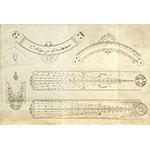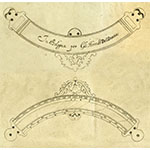Galileo's (1564-1642) compass is composed of two legs and a quadrant carrying several proportional scales.
The quadrant displays:
- a twelve-point division that serves as a gunner's square. The use of the compass as a gunner's square, writes Galileo, "is that you put one of its sides in a slot in the gun, having first suspended the plumb line from the center of the instrument; the line will show the gun's elevation";
- lines for the astronomical quadrant, used to calculate the altitude of a star above the horizon with the help of a plumb line;
- a "scale of slopes" to measure the gradient of scarps of fortresses;
- a scale to measure heights, distances, and depths, using the properties of similar triangles (shadow square).
The front of Galileo's compass carries four pairs of scales:
- arithmetic lines, 245 mm in length, divided into 260 equal parts, used for a variety of proportional calculations;
- geometric lines, for solving the following problem: given a regular polygon, find the side of another polygon with the same number of sides, but with area n times the area of the first polygon; these lines can also be used to extract of the square root of a number;
- stereometric lines, for finding the solid with a volume n times that of a given solid;
- metal lines, used, as Galileo says, to give "proportions and differences in weight between the materials indicated on them"—in other words, to determine the specific weights of metals.
On the back are engraved:
- polygraphic lines, for finding, from a side of given length, the circle circumscribed around a regular polygon with any number of sides;
- tetragonic lines, for finding the side of a square, pentagon, hexagon or other polygon with the same area as a circle of given radius, and vice versa;
- adjunct lines, "added" to the tetragonic lines for finding the square of the same area as a circular segment of given chord and radius.










